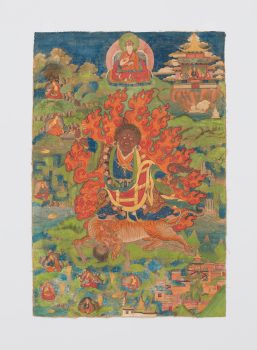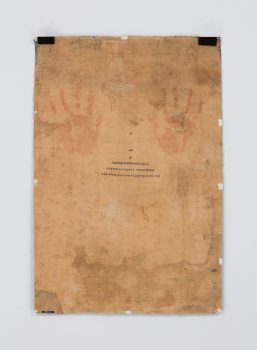Bhutan or Central Tibet
18th century
A vajra is a ritual scepter used in tantric practices and an attribute of tantric masters and deities. It generally symbolizes method, the male aspect of enlightenment.
Bhutan or Central Tibet
18th century


Dorje Drolo, or the Wrathful Vajra, is one of the 8 manifestations of the legendary Buddhist master Padmasambhava. Revered as the Second Buddha in Tibetan Buddhist culture, Padmasambhava is believed to have manifested as the wrathful Dorje Drolo to fly to 13 places named Tiger’s Lair (Taktsang) and subdue local deities. He bound them by oath to protect his teachings and imprinted his hands and feet in the landscape. Handprints and footprints are impressed throughout the landscape of this painting. They are most concentrated in the lower left corner, amidst images of Padmasambhava meditating in caves, where he made imprints in rocks and hid his teachings as treasures (terma) for his reborn disciples to reveal at later dates. The two handprints on the left side are inscribed Namsto Cave, which is a place where Padmasambhava is said to have left such marks “to inspire faith in future generations.”One detail of note is an imprint of Padmasambhava’s full body located in the lower center of the painting, center-right in this image, which depicts a famous site in Bhutan frequented by pilgrims.
A religious movement that originated in India around the fifth to seventh century with sacred writings and esoteric teachings and practices transmitted from teacher to student through initiation. These remain an important part of Hinduism and Buddhism today.
A kind of energy that can be used, individually and collectively, to effect change.
Buddhists believe identity is not fixed but is variable and dependent on causes and conditions. It is a temporary, transitional, and ever-changing interplay of mental and physical elements.
Protectors of Buddhist teachings who destroy obstacles that impede the path to enlightenment. The more frightening and gruesome their appearance, the greater their power.
Today, Tibetans primarily inhabit the Tibetan Plateau, situated between the Himalayan mountain range and the Indian subcontinent to the west, Chinese cultural regions to the east, and Mongolian cultural regions to the northeast. During the 7th to 9th century, Tibetan rulers expanded their empire across Central Asia, and established Buddhism as the state religion.
Get the latest news and stories from the Rubin, plus occasional information on how to support our work.